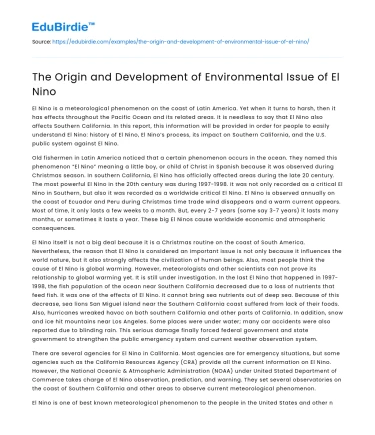El Nino is a meteorological phenomenon on the coast of Latin America. Yet when it turns to harsh, then it has effects throughout the Pacific Ocean and its related areas. It is needless to say that El Nino also affects Southern California. In this report, this information will be provided in order for people to easily understand El Nino: history of El Nino, El Nino’s process, its impact on Southern California, and the U.S. public system against El Nino.
Old fishermen in Latin America noticed that a certain phenomenon occurs in the ocean. They named this phenomenon “El Nino” meaning a little boy, or child of Christ in Spanish because it was observed during Christmas season. In southern California, El Nino has officially affected areas during the late 20 century. The most powerful El Nino in the 20th century was during 1997-1998. It was not only recorded as a critical El Nino in Southern, but also it was recorded as a worldwide critical El Nino. El Nino is observed annually on the coast of Ecuador and Peru during Christmas time trade wind disappears and a warm current appears. Most of time, it only lasts a few weeks to a month. But, every 2-7 years (some say 3-7 years) it lasts many months, or sometimes it lasts a year. These big El Ninos cause worldwide economic and atmospheric consequences.
Save your time!
We can take care of your essay
- Proper editing and formatting
- Free revision, title page, and bibliography
- Flexible prices and money-back guarantee
El Nino itself is not a big deal because it is a Christmas routine on the coast of South America. Nevertheless, the reason that El Nino is considered an important issue is not only because it influences the world nature, but it also strongly affects the civilization of human beings. Also, most people think the cause of El Nino is global warming. However, meteorologists and other scientists can not prove its relationship to global warming yet. It is still under investigation. In the last El Nino that happened in 1997-1998, the fish population of the ocean near Southern California decreased due to a loss of nutrients that feed fish. It was one of the effects of El Nino. It cannot bring sea nutrients out of deep sea. Because of this decrease, sea lions San Miguel island near the Southern California coast suffered from lack of their foods. Also, hurricanes wreaked havoc on both southern California and other parts of California. In addition, snow and ice hit mountains near Los Angeles. Some places were under water; many car accidents were also reported due to blinding rain. This serious damage finally forced federal government and state government to strengthen the public emergency system and current weather observation system.
There are several agencies for El Nino in California. Most agencies are for emergency situations, but some agencies such as the California Resources Agency (CRA) provide all the current information on El Nino. However, the National Oceanic & Atmospheric Administration (NOAA) under United Stated Department of Commerce takes charge of El Nino observation, prediction, and warning. They set several observatories on the coast of Southern California and other areas to observe current meteorological phenomenon.
El Nino is one of best known meteorological phenomenon to the people in the United States and other nations that are located in the Pacific Ocean. No body knows why El Nino occurs, even scientists. Although scientists are still investigating to discover why El Nino occurs, it may not be found for long time. El Nino, that has great power to influence the world, is not a match to its name (remember it means “little boy”). Many people think it is bad for the world, but most meteorologists have no doubt that it is good for the world. El Nino affects human’s life in accordance with its name (remember it also means child of Christ).






 Stuck on your essay?
Stuck on your essay?

